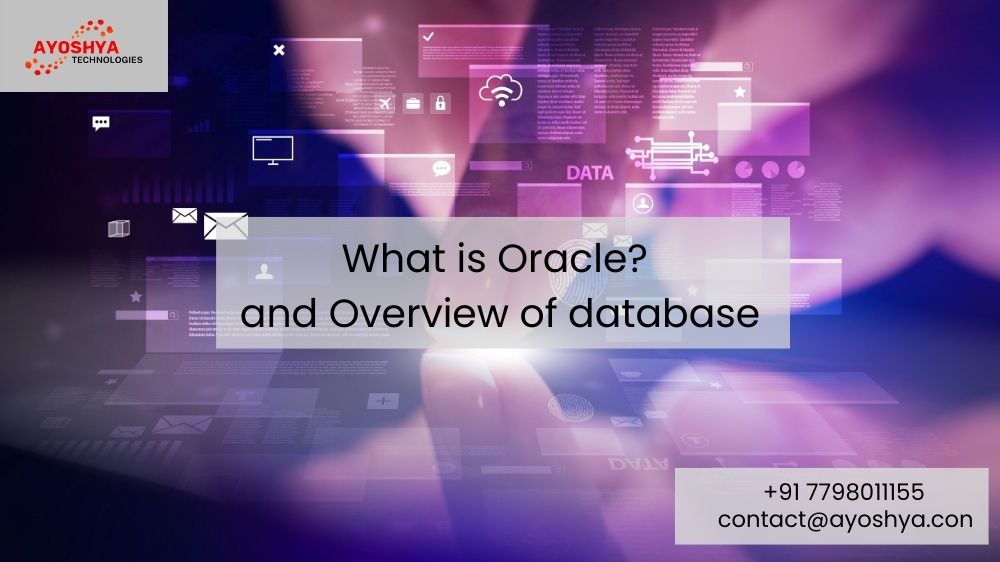What is Oracle? and an Overview of the Database
Oracle is another name for its database. It is a relational database management system with several models. The customer can choose the database system that best matches their needs from Oracle’s RDBMS range of product versions, which include Standard Edition, Enterprise Edition, Express Edition, and Personal Edition. Oracle’s RDBMS can handle any data model. Oracle systems are scalable, secure, and have superior performance capabilities when compared to other databases on the market.
Oracle is another name for its database. It is a relational database management system with a number of models that are primarily designed for data warehousing and enterprise grid computing.
It supports SQL as a query language as a database interface. It is the most flexible and economical approach to handling data and applications. Enterprise grid computing produces enormous pools of modular, industry-standard storage and servers. This approach enables speedy provisioning of each new system from the pool of components. Since capacity can be added or reallocated from resource pools as needed, peak workloads are unnecessary.
There are now five editions of its database available, each with a different set of features.
Standard Edition One :For single-server or highly branched commercial applications that just need a few functionalities, is intended.
Standard Edition: Every feature found in Standard Edition One is present in this edition. Larger machine support and Oracle Real Application Clustering are also included.
Enterprise Edition: For mission-critical applications involving online transaction processing, this edition offers security, performance, scalability, and availability.
Express Edition: is simple to install, administer, develop, and deploy the free entry-level version.
The Personal Edition, with the exception of Oracle Real Application Clustering, provides the same capabilities as the Enterprise Edition.
A crucial feature of Oracle’s design is the division between logical and physical components. For large-scale distributed computing, also known as grid computing, this layout means that the data location is immaterial and transparent to the user, enabling a more flexible physical structure that may be added to or altered without affecting the database’s activity, data, or users.
Data networks can be incredibly flexible because of this resource sharing, with capacity that can be modified up or down to match demand without impacting service. Additionally, it makes it possible to build a robust system because of the networked storage resources. The The schema makes sure that any failure is local, preventing the database from going down in a single place.
The main benefit of Oracle DB is that it is more cost-effective in enterprise environments since it is more scalable than SQL. This implies that if a business needs a lot of databases to store data, they may be quickly and efficiently built and accessed without any downtime. Because of Oracle’s structural characteristics, which include Memory caching guarantees the greatest performance for extremely large databases. High-performance partitioning can be used to divide larger data tables into many pieces. The use of numerous backup and recovery methods is supported, such as the comprehensive Recovery Manager tool that offers incremental, hot, and cold backups and recoveries (RMAN).
Overview of the Physical Database Structures
Datafiles
Every Oracle database has one or more physical data files. All of the database information is stored in the data files. Physically, the database’s datafiles house the data of logical database structures like tables and indexes.
The following traits apply to datafiles:
- Only one database can be attached to a datafile.
- Datafiles can be specified with certain features to enable automatic expansion when the database reaches its limit.
- A logical database storage container made up of one or more datafiles is called a tablespace.
Data in a datafile is read as needed during regular database operation and saved in Oracle’s memory cache. Think about a user who wants to obtain information from a database table. If the desired data isn’t already recorded in memory by the database, it is retrieved from the relevant datafiles and done so.
Database Structures with Logic Overview
Oracle’s logical storage structures, which include data blocks, extents, and segments, provide fine-grained control of disc space utilization.
Tablespaces, which are logical storage containers that group together relevant logical objects, are used to organize databases. For instance, tablespaces are used to group all application objects together in order to simplify some administrative duties.
Each database is logically divided into one or more tablespaces. In order to physically store the data of all logical structures in a tablespace, one or more datafiles are constructed for each tablespace. The total size of a tablespace’s datafiles determines how much storage it has. Every Oracle database has a SYSTEM tablespace and a SYSAUX tablespace.
Oracle automatically creates them when the database is created. The system automatically constructs a smallfile tablespace, the most typical type of Oracle tablespace. For the SYSTEM and SYSAUX tablespaces, smallfile tablespaces are created.
Bigfile tablespaces can also be built into Oracle. Rather than storing tablespaces as a collection of smaller files, this allows the Oracle Database to store them as a single, enormous file.
The ability to produce and manage extraordinarily large files on 64-bit platforms is thus made available to Oracle Database. As a result, the Oracle Database can now scale up to 8 exabytes in size. Big file tablespaces use Oracle-managed files to completely hide data files from users. In other words, you can perform operations on tablespaces rather than the underlying data files.
The Value of Oracle
One of the world’s oldest database management companies is this one. The company has consistently put business needs first and kept up with emerging technologies. As a result, new features are regularly added to its products. For instance, Oracle Cloud also offers 19C, the latest Oracle database. Oracle gives users the option to choose from a range of database editions to fit their unique requirements and provide an affordable solution.



